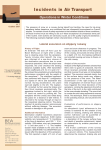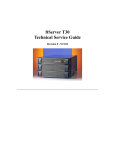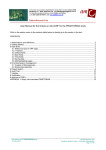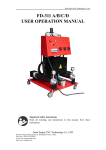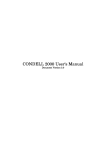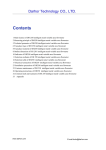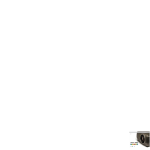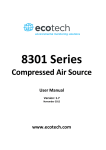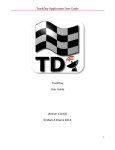Download - Car
Transcript
Brake tester – decelerometer CT3010 CAR-TECH USER’S GUIDE Version 8.++ Index Chapter 1 - Application and measurements - Specifications - Decelerometer accessories and options - Principle of measurement - Report printing 1.1 1.2 1.3 1.4 1.5 Chapter 2 - Control Panel and Configuration - Configuration - Calibration, Measurements and Printing - Menu Selection - Data Clearing - Recording Interval - The six possibilities to start the measurement - Threshold - Display Contrast - Backlight - Time and Date - Header of the report - Filter - Basic Menu Settings - Connection to a PC - Stability of the Measurement 2.1 2.2 2.3 2.4 2.4.0 2.4.1 2.4.2 2.4.3 2.4.4 2.4.5 2.4.6 2.4.7 2.4.8 2.4.9 2.5 2.6 Chapter 3 - Service and Maintenance - Battery Charging - Replacement of paper and ink ribbon 3.1 3.2 3.3 2 Glossary Application Fast check up of brake systems of the traffic vehicles intended for: • stations for the technical inspections of cars • car repair shops • car owners • the benefit of judicial experts and police Type: Portable Decelerometer set with built-in printer, LCD display and keyboard, including the software for PC Windows. Optional connection of force sensor or pressure sensor. Measured quantities: The measurement of the overall brake deceleration and its dependence on the controlling force applied to the brake pedal or its dependence on the air pressure in the air pressure brakes. The results of measurements are graphs of the time dependencies and the numerical calculated average value of the overall deceleration Specifications: Maximal braking deceleration ... 20 m/s2 Controlling force applied to the brake pedal ... up to 1000 N Air pressure in the air pressure brake.... up to 1 MPa Hydro pressure in the oil pressure brake.... up to 20 MPa (option) Weight... up to 8T (option) Sampling rate 1..50s for CT3010 Sampling rate 5..300s for CT3010XL Printing • graph with numerical values • date and time of measurements • company headings • two lines of measurement confirmation Power supply • build in NiMH rechargeable battery. Charging from AC adapter. Measured data memory • storage of 128 measurements. Possibility of printing any of the stored measurements. 3 Decelerometer CT 3010 accessories • force sensor for the measurement of the force applied to the brake pedal • pressure sensor for the air pressure measurement in the air pressure brake • AC adapter for charging of the NiMH battery • external start button • interface cable for connection to PC computer • Software Program for Windows • User’s manual • Carrying Case 4 Chapter 1 1.1 Application and measurements Decelerometer is used for the measurement of the overall brake deceleration of the traffic vehicles. The value of deceleration is measured, as well as its dependence on the controlling force applied to the brake pedal or its dependence on the air pressure in the air pressure brakes. The results of measurements are: graphical records time related, the numerical calculated average value of overall deceleration and the average value of control force or the average value of air pressure. The following three options can be ordered: - Decelerometer only - Decelerometer with external sensor for controlling force applied to the brake pedal - Decelerometer with external sensor for air pressure in the air pressure brake system The measurement of the controlling force applied to the brake pedal and the measurement of the air pressure in the air pressure brake is possible only with the external force sensor or with the external pressure sensor. After the required sensor is connected, the decelerometer will configure automatically. The external sensors are supplied as accessories. External sensors from different decelerometers are not exchangeable without the manufacturer’s calibration. The measurement is very easy. The instrument must be placed into the vehicle in such a way, that the arrow on the instrument coincides with the direction of travel. With the help of levelling screws and built-in levelling libel the instrument is adjusted into exact horizontal position. After switching-on, the display leads through the instructions. When the calibration is finished, the vehicle can be set into the motion. The measurement is started by pressing the starting button. Than the vehicle is slowed-down until stop by its braking system. The wheels are not allowed to blocked. The maximal values appear at the display and the detailed report is printed. The results of measurements will remain in the internal memory as long as the power is switched-on. 1.2 Specifications Design and specifications of the decelerometer are based on the regulation of Ministry of transport,“ About regular technical inspections and emission measurements of the road-bound vehicles “ No 103/1995 Sb/CZ. Measurement Ranges: - Braking deceleration 0 - 20 ms-2 - Controlling force applied to the brake pedal 0 - 1000 N - Air pressure in the air pressure brake 0 - 1 MPa Accuracy of the measurements: - braking deceleration +/- 3 % - controlling force applied to the brake pedal +/- 35 N - air pressure in the air pressure brake +/- 25 kPa 5 Printing : - Company headings - Date and time - Graphical expression with numerical values - Two lines containing the confirmation of measurement - Additional information about decelerometer configuration Power supply: - build in NiMH rechargeable battery, charging from AC adapter Measured flash data memory: - Memory for up to 128 measurements. Printing of any stored measurement Features: - Two line LCD display with back light - Keypad with 9 keys - Built-in matrix printer - Possible connection to PC with control and evaluation program 1.3 Decelerometer accessories and options The decelerometer consists of measuring instrument itself, set of options and accessories which facilitate the measurements: - Decelerometer CT3010 - Pressure sensor 1MPa with a cable - Force sensor 1000N with a cable - External start button - AC adapter for NiMH battery - interface cable for connection to PC computer - Diskette with program for PC (Windows) - Extra paper for the printer - Users manual - Carrying Case Option (extra order) - Pressure hydro 20MPa sensor with cable - Weight sensor 8T with cable Use the pressure sensor or the force sensor, depending on the application. The interface cable to PC computer may be connected. The decelerometer may be configured and used as stand alone or the measured data may be transferred to the PC. With the help of external start button the measurement can be initiated by the driver of the vehicle. 6 1.4 The principle of measurement The measurement is based on simultaneous recording of vehicle brake deceleration and the controlling force applied to the brake pedal, or recording of the vehicle deceleration and the air pressure in the air pressure braking system. All data are stored in the internal memory after the button Start has been applied. The measurement of the deceleration, the controlling force applied to the brake pedal and the air pressure in the air pressure brake is realised with the build-in deceleration sensor, the force sensor or the pressure sensor. At the end of the measurement the maximal values are shown at the display. A detailed report is printed. During the printing the average value of the overall deceleration, the average value of control force or the average value of the air pressure is calculated. At the beginning of the measurement, the recording interval has to be set. The range of setting is from 1 to 50 seconds (5 to 300 seconds for CT3010XL). An averaging filter is available with a filtering constant from 0 (no filter) to 10 (long time constant). There are more possibilities to start the measurement and the recording: Starting button MEAS External starting button Setting the threshold value or combination of the these above. The recording clearly shows whether the measured smallest average value of the overall deceleration is as prescribed, and whether the controlling force applied to the brake pedal or the air pressure have achieved the required values. The results of measurements (up to 128 data sets) will be stored in its flash memory and may be printed. With the help of the supplied program, the records may be transferred to the PC. After each measurement the hydro sensor or the weight sensor can be connected and used. Press the button MEAS again. After the display shows steady reading, press MEAS again. The pressure or weight measurement are stored. 7 1.5 Report printing When all measurements are stored in the memory, the report can be printed. The record contains the company’s head (can be disabled), time and date, and the measured values versus time. The maximum deceleration value and the duration of measurements will be printed as well. After entering the time interval, in which the average values have to be calculated, the average value of overall deceleration and the average value of the force or the air pressure will be calculated and printed. If hydro sensor or weight sensor is used, their results will be printed as well. Two lines of text are added to the printed report, containing the identification of vehicles and confirmation of the measurement. The printing on the 57.5mm wide paper is done with ink. This guarantee long lasting quality. The printing of one report takes about 15 seconds. The report may be printed several times, but the selected interval in which the average values have to be calculated must be entered all the time. The reports of previous measurements may be printed more times as well. 8 Chapter 2 2.1 Control Panel and Configuration The Decelerometer CT3010 is controlled by using the front panel keyboard, with poweron/off keys. Three keys are used in the measurement mode, and four keys in the menu mode. With the keys ON and OFF the power is applied to the instrument. After the power is switched on, the display shows Brake tester *** eter The internal memory and the calibration data are tested. The time and date is displayed for 3 seconds, provided that the internal clock is set. After this test the following text will be displayed Horizont set with screw The instrument has to be set into exact horizontal position with the help of levelling screws and built-in levelling libel. This step is mandatory in order to garantee the correct function of the decelerometer. Pressing of any key initiates the calibration, the setting of zero offset and starting of the configuration test. At the end the selected configuration of decelerometer is displayed for the short time. 9 Decelerometer only: Deceleromete r Decelerometer and external force sensor: Deceleromete r Force sensor Decelerometer and external pressure sensor: Deceleromete r Pressure The instrument requests for switching into the measuring or the menu mode. Select funct ion Selection by MEAS or MENU. When a measurement has already been done, this information appears, e.g. with decelerometer only: Measure N. 1 Max 9.8 m/s2 Decelerometer and external force sensor: Measure N. 1 9.8 m/s2 500N Decelerometer and external pressure sensor: Measure N. 1 9.8 m/s2 300kPa 10 2.2 Configuration By pressing the appropriate keys in the mode measurement, the measurement, the calibration or the printing can be started, or the previous measurement can be displayed. By pressing MENU the menu mode is initiated, which is described in detail in the paragraph 2.4. 2.3 Calibration, Measurements and Printing. In the measuring mode the instrument measures, calibrates or prints the data. Any of these activities may be selected by depressing one of the keys MEAS, CAL or PRN. After pressing CAL the offsets of the deceleration sensor, the force sensor or the pressure sensor are set for zero reference values. Calibr.,offset wait …. When MEAS is pressed, the mode changes into measurement. The decelerometer waits for some time until the conditions for the correct measurements are fulfilled. This time delay depends on the decelerometer configuration, on the set threshold and on the way how the measurement will be started. As soon as these conditions are met, the measurement starts and the results are recorded during the time interval set in the mode menu. The values of deceleration, force or pressure are calculated. The measured data are filtered in accordance with the filter setting. At the end of measurement the maximal values of deceleration, force or pressure are displayed, as well as the serial number of the measurement. After pressing PRN, the paper from the printer is advanced. When pressed longer, the data is printed as a graph. Papier eject or printing After this text the print can be selected For printing Push button 11 After the graph is finished, the average values of overall deceleration, force or pressure will be printed. The beginning and the end of the time interval, in which the average values have to be calculated, must be entered with help of up and down keys. The interval has to be selected in which the deceleration is steady, nearly constant. start 0.8 s value 6.0m/s2 The selected values have to be confirmed by pressing the right arrow cursor. The beginning of the interval is determined first. The end of the interval has to be confirmed afterwards. end 2.5 s value 3.4m/s2 The average values of measured parameters are calculated within this interval only. Afterwards the second part of the report is printed. When MEAS is pressed again, the new measurement is initiated. The previous measurements are not deleted, but stored in the memory. Up to 128 measurements can be stored. By using the down arrow key the previous measurement can be called. With the up arrow key the next measurement can be started. The serial numbers of the selected measurements are displayed. With 14 measurements the capacity of the memory is exhausted. Next measurements may be done as described in 2.4.0. 2.4 Menu Selection By pressing MENU the instrument enters the menu mode. This mode is for setting of the time interval, the recording, the starting way of the measurement, setting of the threshold, the display contrast, the backlight, the time and the date, the texts of the head, the transfer rate and the filter. The up and the down arrow and the right arrow keys will be used. By pressing MEAS the measuring mode is initiated (see 2.3). 12 2.4.0 Data Clearing After pressing MENU following text appears: Data clearing N hh:mm:ss After pressing right arrow the measured data N (1..128) at time hh:mm:ss and date dd.mm will be deleted. All records 2..128 are shifted to 1..127. After erasing all data the following text will be displayed: *** No data ** ************ All data can be deleted at the same time when the key right arrow is pressed for a longer time. All clearing push button Display blinking. After 10 seconds all data are erased. When PRN is pressed, the paper is ejected from the printer. When pressed longer, the list of all measured stored is printed. 2.4.1 Recording Interval After pressing MENU following text will be displayed Sample setting Recording xx With up arrow and down arrow the recording interval can be set from 1 to 50 seconds (5 to 300 seconds for ct3010XL). 13 2.4.2 Six possibilities how to initiate the measurement After pressing MENU one of the six possible ways of initiating the measurement can be selected. The selection is with up or down arrow keys. Start with the key MEAS Start setting Internal=M Start with the external button Start setting External button Start when the deceleration threshold is higher then value set Start setting Decel.thresho ld Start when the force/pressure threshold is higher then value set Start setting Thres.frce/pre ss Start with external button and the deceleration threshold higher then the value set Start setting Butt.+decel. Start with external button and force/pressure threshold higher then the value set Start setting Butt.+frce/pr. 14 2.4.3 Threshold After pressing MENU the display will show: Threshold set Value xx % By using the up and down arrows the threshold can be set in % from the upper limit XX. The upper limit of deceleration is 20 m/s 2, for the force 1000N and for the pressure 1MPa. The limit of deceleration, force or pressure will be selected in accordance with the configuration of the decelerometer (see 1.1) 2.4.4 Display Contrast After pressing MENU the display will show: Contrast sel Higher - lower Set the required contrast with up and down arrows. 2.4.5 Backlight After pressing MENU the display will show: Backgr. light On - Off Set the required light with up and down arrows. 15 2.4.6 Time and Date After pressing MENU the display will show: Time hh:mm:ss dd.mm.yyyy Point to the value to be changed with the right arrow cursor (flashing). With up and down arrows set the value. 2.4.7 Header of the Report After pressing MENU the display will show: Line 1: Text in the line 1 Decelerometer The text is a factory default. Each line contains three parts. The bottom line contains one third of the text which is going to be printed. The text can be changed with the cursor keys or from PC by using the SW program enclosed. The exclamation mark at the first position on the line prevents the printing of the text. The letter being set is flashing. The cursor can be moved to the right only. After the first part of the first line is displayed, the entry of the second part of the first text line and then the third part of the first line can be performed. After the third part of the line is entered, the cursor will return to the first position of the line. The following three lines will be set similarly. By pressing MENU the next line will be enabled for entry. Line 2: Text in the line 2 Orbit Controls Line 3: Text in the line 3 Zurcherstrasse Line 4: Text in the line 4 Manufacture 16 2.4.8 Filter After pressing MENU the display will show: Setting of filter Multiplicity : By pressing up or down arrow the filter constant can be set. The range is from 1 to 10. 2.4.9 Basic Menu Settings. The factory default settings is suitable for most general applications. Recording interval 5 s Initialising the measurement with the deceleration threshold Threshold value 20 % Display contrast higher Background lighting yes Time and Date set in the factory Header of the report set in the factory Auto switched on Filter multiplicity 1 After the setting the decelerometer can be placed into the vehicle, switched-on and leveled into the horizontal position. The vehicle can be moved to the required speed and the key MEAS pressed. When the vehicle stops due to the function of its own braking system, the report of the measurements will be printed. The recording time is 5 sec. The measurements will start at the beginning of the braking action. 17 2.5 Connection to a PC The software program for Windows is enclosed to each decelerometer. The program starts by clicking on the icon CT3010. The communication with a PC is via the serial data port RS232. When only the recently stored data are processed and the decelerometer shall not be reconfigured, the connection to the PC is not required. The communication between the decelerometer and the PC is only in the measurement mode. It is not possible to connect the decelerometer to the PC while performing the measurement. 2.6 Stability of the Measurement The error free measurements are guaranteed for the ambient temperature 0 oC to 30 oC. The electronics, the deceleration sensor and the external sensors are factory calibrated. The accuracy described in 1.2 is guaranteed. The factory calibration constants are stored in the memory and are checked every time, when the power is turned on. When the stored parameters change, the display informs about the necessity of urgent recalibration. The decelerometer with all accessories has to be returned to the factory for recalibration. 18 Chapter 3 3.1 Service and Maintenance The paper and the ribbon of the printer have to be replaced when necessary. The battery has to be charged with the enclosed battery charger (9V, 1.2A) in regular intervals. The printer is prone to dust environments. All repairs of the decelerometer should be performed by the manufacturer. 3.2 Battery Charging When the message "Warning! It is time to charge the accumulator" is displayed, the battery has to be charged. When the battery voltage is bellow a certain limit, the backlight of the display is automatically switched off. When the instrument is not used for a longer time, the battery has to be fully charged. It is recommended to charge the battery one in a month. The battery has to be charged only when the decelerometer is switched off, otherwise the instrument could be damaged. Do not use the decelerometer switched-on with the battery charger connected. The green LED flashes during the battery is being charged. When the battery is fully charged, the LED lights continuously. The charging time is approx. 3 hours. The electronic prevents overcharging of the battery. The battery life expectation is about 1000 charging cycles. Charge the battery at the room temperature. The charging level may roughly be checked by pressing the right arrow cursor key at the time, when the display prompts to select the measurement or menu mode. When the key is pressed for longer time, the display shows the battery voltage. The fully charged battery shows 5.6 Volts. 3.3 Replacement of paper and ink ribbon. The paper can be replaced after the printer cover with label has been opened. The paper width is 57.5mm. When PRN is pressed, the paper is advanced into the printer. The proper function of the printer can be checked by pressing PRN for longer time. The head of the Report will be printed. It is recommended to use the wood free paper supplied by the manufacturer of the decelerometer. Otherwise the printing matrix might be damaged. The ink ribbon can be replaced after the paper has been removed from the printer. The cartridge will be shifted sideward by pressing at the point PUSH. The new cartridge can be inserted and the ribbon tightened by the notched wheel on the left side. Last update: 14 / 6 / 2010 19



















